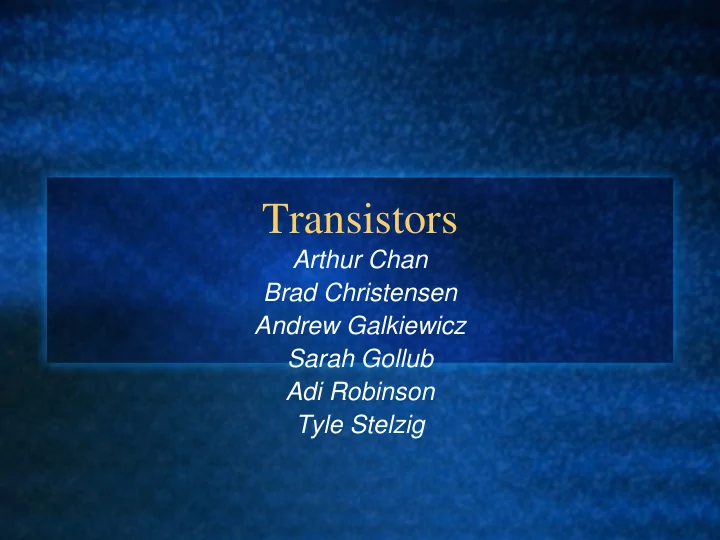

Transistors Arthur Chan Brad Christensen Andrew Galkiewicz Sarah Gollub Adi Robinson Tyle Stelzig
HAPPY 60th BIRTHDAY!
History � First conceived and patented in 1928 by Julius Lilienfeld � During WWII, research into semiconductors like geranium and silicon intensified � First transistor was made by John Bardeen, Walter Brattain in 1947 http://www.ieee.org/portal/cms_docs_sscs/ss cs/07Spring/HR-1stTransistor.jpg
More History � William Shockley led the effort in the creation of the junction transistor in the early 1950s http://th.physik.uni-frankfurt.de/~jr/gif/phys/bsb.jpg
How Transistors Work Bipolar Junction Transistors � NPN (most common) – uses electrons as carrier of current. � PNP – uses the lack of electrons (“holes”).
The Physics of It � An insulating effect occurs where the P-type and N- type are in contact. This interface is called a ‘depletion zone’. � This insulating effect decreases when a voltage of the correct polarity is applied � Apply a voltage across the collector and emitter. � There’s a depletion zone between collector and base. � Electrons which wander across the base are forced across the upper depletion zone by the applied voltage. � The base depletion zone thus controls the collector battery current. � This base depletion zone is controlled by the base voltage.
Diagram ________ Light / \ Bulb | ________/\/\/\________ | | | | | \________/ | v | | | | | ______|______ | | | Collector | | COLLECTOR N | Thick depletion Battery | + |_____________| layer with electrons | _____________ <-- passing through ____|____ | |______________ _____ | BASE P | | _________ |=============| | + _____ 9V | | ____|____ _________ | EMITTER N | _____ Base _____ |_____________| _________ Battery _________ | _____ .7V _____ | | - | - |_____________________| |______________________| ------> Source of diagram: http://amasci.com/amateur/transis2.html
Transistors as Amplifiers � The base/input voltage controls how much of the current supplied by the supply voltage (labeled ‘Vcc’) flows through the transistor itself, and how much acts as V out . � Small changes in the base voltage will produce large changes in V out . � You can think of a transistor like a valve: the base/input voltage controls how much of the supply voltage is allowed through. � The ratio between the current through the collector and the current through the base is defined as h FE . � Unless the transistor is saturated, the current gain equals h FE . � Typically h FE is 100. � “Darlington pair” is when multiple transistors are connected, thus h FE = h FE1 x h FE2 .
Transistors as Switches � Once the base voltage reaches a certain level, no additional current will flow � This level is referred to as ‘saturation’ � The input voltage can therefore be chosen so that the output is in one of only two possible states (ON or OFF) � This allows transistors to be used as switches Diagram: http://en.wikipedia.org/wiki/How_a_Transistor_Works
Field Effect Transistors � Only has two layers of semiconductor material. � Electricity flows from one layer called the channel to the other layer called the gate. The voltage across the gate interferes with the � current, thus controlling its strength.
Logic Gates When high voltage is applied to the base , � the transistor behaves like a switch allowing current to flow from the collector to the emitter. If the collector is connected to the � resistor, and a high voltage is applied to the base, current flows through the transistor causing a voltage drop across the resistor. In this case V out is low. � So if V in has high voltage, V out has low voltage. � If V in has low voltage, current does not flow through the resistor. Thus there is no voltage drop across the resistor and high voltage accumulates at Vout . � So if V in is low, V out is high. This arrangement of transistors acts as a � NOT-gate. Other arrangements can act as other � logical gates. � Using such gates in series allows for the construction of computers.
Main technologies for Transistor Design Silicon- Usually refers to bipolar devices in SiGe Germanium technology, although SiGe FETs are also viable (SiGe) MOS Metal Oxide Semiconductor Bipolar is a term used to describe a junction based Bipolar transistor as distinct from a field effect transistor Bipolar Complementary Metal Oxide BiCMOS Semiconductor
Distinct Characteristics of the Modern Applications � 2 improvements made on the BJTs and FETs � Used more in digital circuits than analog circuits. e.g. RAM, � Transistors tend to be integrated into integrated circuits – digital output
Examples � temperature censors (analog output) � Ic rises exponentially with base-emitter voltage (0.6- 0.7V for Si) � Usable when containing >1 transistor, or in an ideal device � Not useful alone, as Ic depends on voltage as well as outdoor temperature � calculators of log and other functions � Transistors store binary numbers by switching electric currents on and off � Logic gates; compares 2 currents
Future Design Twisted Ballistic Transistor � Electrons follow a ballistic trajectory into � and out of junction (bumper) How it works � gate structure crossroads design � � electric field at center of y-shaped non- conductive intersection � inertia; electric field around the block; ballistic trajectory Electrons apply varying voltage � differential an indium gallium arsenide-indium � aluminum arsenide substrate increases electron flow and produces conduction � current need not be present due to magnets � Binary 1s and 0s � semiconductor sheet 2D electron gas
Moore’s Law � The conjecture that the most cost- effective number of transistors per unit area on an integrated circuit will double every 12-24 months is known as Moore’s Law. � This has proven true! � The development of transistors has allowed for this phenomenal increase in density, and thus SPEED.
Recommend
More recommend